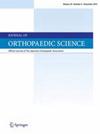Relationship between the medial cuneiform bone morphology and the severity of hallux valgus
IF 1.5
4区 医学
Q3 ORTHOPEDICS
引用次数: 0
Abstract
Background
It has been reported on the relationship between the medial cuneiform bone morphology, especially in terms of obliquity, and the severity of hallux valgus (HV), however, no consensus has been obtained. On the other hand, there are no reports on the relationship between the difference in height between the medial and intermediate cuneiforms and the severity of hallux valgus. The purpose of this study was to clarify the relationship between the medial cuneiform bone morphology and the severity of HV.
Methods
The authors retrospectively analyzed 200 feet of 116 patients who had a weightbearing anteroposterior foot radiograph taken between April 2017 and July 2022 and diagnosed with HV. Measurements included the hallux valgus angle (HVA), the intermetatarsal angle (IMA), the distal medial cuneiform angle (DMCA) and the cuneiform first-second length (C1-2D). HV groups were classified into one of three groups: mild (15 ≦ HVA<30°, 9 < IMA<13°), moderate (30 ≦ HVA<40°, 13 ≦ IMA≦20°) and severe groups (HVA≧40°, IMA>20°), and the relationship to DMCA or the difference in height between the medial and intermediate cuneiforms was analyzed.
Results
A total of 163 feet of 93 patients were included in this study. There were significant correlations between the HVA and the DMCA (r = 0.47, p < 0.001) or the C1-2D (r = 0.64, p < 0.001). There was no significant difference in DMCA between the mild and moderate groups (p = 0.14). On the other hand, significant differences in C1-2D were observed between the three groups (mild-moderate; p < 0.001, moderate-severe; p = 0.03, mild-severe; p < 0.001). IMA was also positively correlated with the DMCA (r = 0.30, p < 0.001) or the C1-2D (r = 0.47, p < 0.001). However, the DMCA (p = 0.07) and the C1-2D (p = 0.39) did not differ significantly from IMA between the moderate and severe groups.
Conclusions
The difference in height between the medial and intermediate cuneiforms, referred to as C1-2D, is closely associated with the HVA. The C1-2D may influence the progression of HV and be a novel radiographic parameter that indicates severity of HV.
内侧楔形骨形态与拇指外翻严重程度之间的关系。
背景:关于内侧楔形骨形态(尤其是斜度)与拇指外翻(HV)严重程度之间的关系,已有相关报道,但尚未达成共识。另一方面,关于内侧楔形骨和中间楔形骨的高度差与拇指外翻严重程度之间的关系,目前还没有相关报道。本研究旨在明确内侧楔骨形态与拇指外翻严重程度之间的关系:作者回顾性分析了在2017年4月至2022年7月期间拍摄了负重足部前后位X光片并被诊断为HV的116名患者的200只足。测量项目包括拇指外翻角度(HVA)、跖骨间角度(IMA)、楔形远端内侧角度(DMCA)和楔形第一秒长度(C1-2D)。HV组被分为三组:轻度组(15 ≦ HVA20°),分析与DMCA的关系或内侧楔面与中间楔面的高度差:本研究共纳入了 93 名患者的 163 只脚。HVA 与 DMCA 之间存在明显的相关性(r = 0.47,p 结论:HVA 与 DMCA 之间存在明显的相关性:楔形内侧和中间的高度差(称为 C1-2D)与 HVA 密切相关。C1-2D 可能会影响 HV 的进展,并成为显示 HV 严重程度的一种新的放射学参数。
本文章由计算机程序翻译,如有差异,请以英文原文为准。
求助全文
约1分钟内获得全文
求助全文
来源期刊

Journal of Orthopaedic Science
医学-整形外科
CiteScore
3.00
自引率
0.00%
发文量
290
审稿时长
90 days
期刊介绍:
The Journal of Orthopaedic Science is the official peer-reviewed journal of the Japanese Orthopaedic Association. The journal publishes the latest researches and topical debates in all fields of clinical and experimental orthopaedics, including musculoskeletal medicine, sports medicine, locomotive syndrome, trauma, paediatrics, oncology and biomaterials, as well as basic researches.
 求助内容:
求助内容: 应助结果提醒方式:
应助结果提醒方式:


